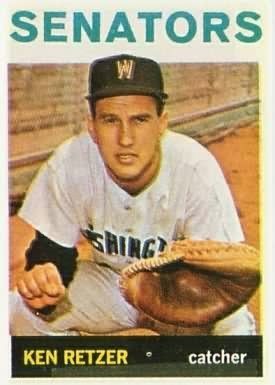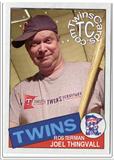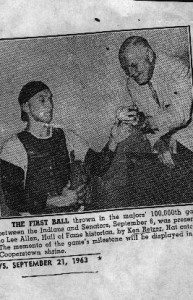I’m a fan of “On the Road With Steve Hartman.”
Ken Retzer
Minnesota Twins Collector Joel Thingvall Helps Build Online Autograph Museum
Imagine the guy in the bar, insistent on getting someone to believe him.
“Really, I almost played for the Minnesota Twins,” he’d protest. “Call Joel Thingvall. He’ll tell you. He’s got my autograph.”
Don’t laugh. There is such a true fan and classic collector. Best of all, Joel’s telling the world about his extensive Twins collection. Instead of dwelling just on Hall of Famers and all-stars, he’s scoured 40-man rosters, minor league team histories and spring training lists to find everyone — including all the ALMOST Twins in team history. Then, Joel is sharing all his conquests on http://www.twinscards.com/, (the internet brainchild of Blake Meyer) offering scans of his massive collection.
Joel shared his insights about the Twins and Twins autographs in this fascinating interview:
Q: How many Twins autographs do you have? What kind of items to you get signed?
Q: Have you made your own cards to get autographed?
A: I have taken to making “custom” 3×5 cards from the mediaguide headers for players, and also using and sizing yearbook images for custom images of newer players or guys that don’t have a regular Twins card.
Q: Do you have any special TTM successes from retired Twins?
A: You always try to be respectful. The older players really love to hear from fans. Ken Retzer (a guy with a Twins card who never played for the Twins) is a real correspondent with fans. Al Worthington is a peach and always sends a packet of articles and stuff back. I managed to track down Bert Cueto, who lived abroad for years, when he moved back to the United States. I actaully find myself sharing memories with players.
Q: Do you believe there have been times that being a true Twins fan or a team-only collector has swayed a tough signer?
A: The internet has allowed you to send a player to a website or a blog, which can show your seriousness (or geekness). The www.twinscards.com site has been great in general to send Twins players to…especially with the minor league guys…..I have heard from many non-major league guys who enjoy seeing cards of their old minor league teammates. Players do like historical aspects of their work! Blogs and websites excite players!
Q: What are the pros and cons of collecting all autographs of a franchise like the Twins, as opposed to a higher-profile team like the Yankees?
A: The plus for collecting Twins is that it is still a young franchise (50 years) and as little as a decade ago, you could write and get most players. That has changed of late, as more pass on. But they pretty much are out there in some shape or form. And people started collecting them early, too…so if you have patience, older collectors are passing on their autographs to a new generation.
Q: Thanks for some great stories, Joel. Any parting advice for collectors?
A: I know players find it strange when grown men are collecting autographs and stuff, especially with the enthusiasm and wide-eyed wonder kids show in the same circumstances. We were all wide-eyed kids at one point or another, but older fans are hardcore collectors and fans, too. Just a little more near/far-sighted and a bit wider than when they were kids.
Us collectors get carried away with completitis, it seems, and often forget that you don’t need everything all the time, so respect the players and think of them as real people, too. Be courteous, don’t over-indulge in what you send or show up with for signatures, and always make reference to a great moment of their days on the field and a big thank-you for taking time out to make a fan’s day brighter!
Catcher Ken Retzer’s Clue to Collectors
One of the best replies I’ve received this year came from Ken Retzer, the Washington Senators catcher. He looked me up and called later to thank me for my letter. Even though he didn’t get lots of chances in the majors, he has remained a fan. I wrote about his fine letter in my March 25 post.
Retzer photocopied photos and clippings from his personal scrapbook. He added notations and autographed each one.
One frequent question from newer collectors and some blog readers is:
What do I ask them about? I never saw them play!
Remember the old saying, “A picture is worth a thousand words.” Go to Google IMAGES. Search for newspaper clippings. Print out an obscure photo. Or, if you have an old yearbook, find an image there. Even a baseball card could work. Where was the photo taken? Who else is in the shot? Which card is their favorite?
Seeing is believing. Let a retiree see what you’re talking about. You may get a story that’s been untold for years.
Be sure to check out this account of corresponding with Mr. Retzer from one of Washington’s greatest fans! Here’s a can’t-miss Senators history website.
Cheers for a Father-Son Hobby Team
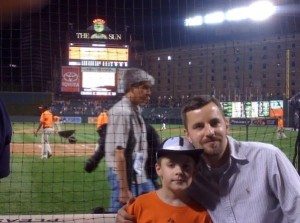
One of my favorite hobby stops is the Autograph Addict.
This site is the collaboration of father-and-son collectors Kyle and Tyler Smego. You might spot them at Camden Yards as many as 30 games a year.
Through the mail, they’re collecting memories.
In January, the Smegos posted 40 questionnaire responses, saying they had a couple hundred more. What’s the current count?
“I try to get these online as quickly as I receive them, but it’s hard to keep up,” Kyle said. “I still have, at least, a couple hundred more that are waiting to be posted. It seems like we get around 10-15 back every month though. In the past we have tried to send the same questionnaire out to all the players (Tyler made up the questions. We try to keep it questions that the players can quickly jot down an answer.”
These “autograph addicts” are gleaning great insights from baseball history makers. Pitching coach Ray Rippelmeyer talked about teaching Steve Carlton the slider. We all know how that experiment turned out.
“Ray was one of the longest letters we have received, but not the longest,” Kyle said. “We have received many responses where the player filled out our questionnaire and wrote a letter. Some of the longer responses include: Rippelmeyer, Duane Pillette, Bobby Shantz, Jake Gibbs, Ernie Broglio, Don Ferrarese, etc….even Phil Niekro and Tony Kubek. All of those guys wrote a page or two or three.”
The Smegos’ best-ever response?
“Our longest correspondence however has been with Ken Retzer,” Kyle said. “I saw that you blogged about him this week. He really is a great guy. He likes to tell stories about his playing days with the Senators, catching JFK, his family, and his business ventures. Over the past year he has sent several letters and included some neat items each time. One time he sent a copy of an old menu from his diner that he used to own (Home Plate), a couple of pictures of his family, some additional pictures of him with JFK, copies of all his baseball cards, etc. He plans on coming out to the DC area sometime soon and I look forward to taking him out to dinner.”
Kyle and Tyler are making the hobby their own. They’ve asked for suggestions for other fun questions they can be asking. Ask someone about what they think of when they see the photo on a certain baseball card.
More than 30 years ago, Twins infielder rolled his eyes and grinned while signing his SSPC “Pure” card. I asked him if he liked that card.
“I think they took photos on the hottest day of spring training right after wind sprints,” I seem to remember Terrell saying. “Look at how sweaty we look. Look at the other Twins cards, and you’ll see what I mean.”
What fun questions do you ask when you write a former player?
Ken Retzer: John F. Kennedy’s Batterymate
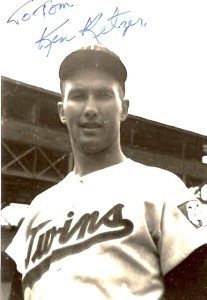
Many people catch the President, on TV, even at a rally.
Ken Retzer caught John F. Kennedy at a ballpark in 1963.
Retzer, starting catcher for the Washington Senators, received the 1963 season’s ceremonial first pitch from JFK.
The Illinois-born receiver enjoyed another milestone that year. Behind the plate for baseball’s 100,000th-ever game, Retzer handled the historic ball that would be displayed in Cooperstown’s Hall of Fame.
I was fascinated to see Retzer’s success in hitting knuckleballers like Hall of Famer Early Wynn. He wrote me:
“I was a line drive hitter,few strikeouts. Just 31 in 1961. So that helps to hit all pitchers. Knuckleballers were hard to catch, almost like catching a butterfly.”
He seemed to wear a different uniform number yearly. Why?
“Any time I veteran player would join the team, I gave up my uniform. The last was #14 for Gil Hodges the manager.”
Twins fans should know that Retzer played a role in the team’s 1965 American League championship. When catchers Earl Battey and Jerry Zimmerman held out, owner Calvin Griffith called Retzer as a bargaining chip. Signing Retzer, who performed admirably throughout spring training, convinced the other two catchers to ink new contracts. Unfortunately, Retzer was cut a day before the season began.
Retzer deserved a World Series. He’s a World Champion autograph signer, giving all-star treatment to every fan who writes. Ask any Senators fan.

